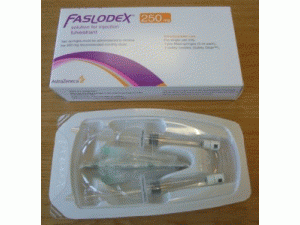氟维司群注射剂FASLODEX 250mg Injektionslösung(fulvestrant)
 药店国别:
产地国家:德国
处方药:是
所属类别: 250毫克/支 2支/盒
包装规格: 250毫克/支 2支/盒
计价单位:盒
生产厂家中文参考译名:
生产厂家英文名:AstraZeneca GmbH
原产地英文商品名:FASLODEX 250mg Injektionslösung 2Stk
原产地英文药品名:fulvestrant
中文参考商品译名:FASLODEX注射剂 250毫克/支 2支/盒
中文参考药品译名:氟维司群
药店国别:
产地国家:德国
处方药:是
所属类别: 250毫克/支 2支/盒
包装规格: 250毫克/支 2支/盒
计价单位:盒
生产厂家中文参考译名:
生产厂家英文名:AstraZeneca GmbH
原产地英文商品名:FASLODEX 250mg Injektionslösung 2Stk
原产地英文药品名:fulvestrant
中文参考商品译名:FASLODEX注射剂 250毫克/支 2支/盒
中文参考药品译名:氟维司群
简介
部份中文Faslodex处方资料(仅供参考) 药品英文名:Fulvestrant 药品别名:Faslodex 药物剂型注射剂:50mg/ml。 药理作用 本品是一类新的雌激素受体拮抗剂——雌激素受体下调剂类抗乳腺癌治疗药物。由于在许多乳腺癌患者中均发现有雌激素受体(ER),且肿瘤生长受到雌激素的刺激,因此降低雌激素的浓度是目前治疗乳腺癌的主要方法之一。本品可以与雌激素受体竞争性结合,亲和力与雌二醇相似;本品还可阻滞受体,抑制雌激素的结合,并激发受体发生形态改变,降低ER浓度而损害肿瘤细胞,这种通过ER通道的作用与细胞增生标志物Ki67的减少有关。本品可下调人体乳腺癌细胞中的ER蛋白,将ER下调在肿瘤细胞内,使肿瘤的生长最小化。由于本品不改变已存在的肿瘤ER状态,不影响新的ER产生,因此肿瘤继续被“程序化”为ER阳性,这样本品持续发生治疗作用。 药动学本 品静注后在体内分布广泛而快速,稳态时表观分布容积约为3~5L/kg,并在肝内快速清除;单次肌注本品后血浆浓度约7天后达到峰值并维持至少1个月,谷浓度约为峰浓度的1/3,t1/2约为40天。每月1次肌注本品250mg后血浆浓度约在3~6次剂量后达稳态,多次剂量后的药时曲线下面积(AUC)是单次剂量的2.5倍,谷浓度与单次剂量的峰浓度相当。本品与血浆蛋白结合率高达99%,主要结合成分为极低密度脂蛋白(VLDL)、低密度脂蛋白(LDL)和高密度脂蛋白(HDL)。肌注和静注本品后在体内进行与内源性甾体激素相似的多种途径的生物转化,包括氧化,芳香酶羟化,与葡萄糖醛酸或硫酸在甾体核的第2、第3和第17位结合,氧化侧链的氧硫基。在已确定的代谢物中大多数无活性或与母体活性相似,并主要从粪便中排出,从肾清除者不到1%,主要代谢酶为CYP3A4。 适应证 本品用于抗雌激素疗法治疗后无效、病情进展或激素受体呈阳性的绝经后妇女转移性晚期乳腺癌的治疗。 禁忌证 对本品过敏者禁用,孕妇禁用。绝经前妇女及儿童不宜使用。 注意事项 1.轻度肝、肾功能受损者可不调整剂量,对肝功能中重度受损及肾功能严重受损者尚未进行评价。 2.不能用于出血性体质、血小板减少或进行抗凝治疗患者。3.2~8℃贮存,避光。 不良反应 本品无他莫昔芬的雌激素作用或抗雌激素作用以及对子宫内膜的部分激动活性,因此不良反应少于他莫昔芬。最常见的不良反应为胃肠道反应(恶心、呕吐、便秘、腹泻和腹痛)、头痛、背痛、潮红、咽炎,注射部位反应多为轻微及一过性疼痛和炎症,其他报道与剂量相关的不良反应还有血栓栓塞、肌痛、眩晕和白细胞减少,但发生率<1%。另外,在治疗前6周从激素治疗转为本品治疗者可能出现阴道出血。 用法用量 肌注,每月1次,每次250mg,可单次注射5ml或分2次注射(1次2.5ml);注射时应慢。 药物相应作用 目前未发现有药物相互作用,未与强的CYP3A4抑制剂之间进行相互作用的研究。英文版说明书
(fulvestrant) significantly improves overall survival for women with hormone-receptor positive breast cancer compared to ARIMIDEX® (anastrozole)The latest findings presented today at the 2014 San Antonio Breast Cancer Symposium (SABCS) show that investigational first-line treatment with fulvestrant resulted in a significant improvement in overall survival (OS) of 5.7 months, compared with anastrozole in post- menopausal patients with hormone-receptor positive (HR+) locally advanced or metastatic breast cancer.These latest OS (a secondary endpoint) results from the Phase II randomized, open-label FIRST (Fulvestrant fIRst-line Study comparing endocrine Treatments) study at a median follow-up of 48.8 months, show an increase in median OS of 5.7 months for fulvestrant compared to anastrozole (54.1 months vs. 48.4 months respectively) and a 30% reduction in the risk of death (HR 0.70; 95% CI 0.50, 0.98; p=0.041). Furthermore, this OS treatment effect was generally consistent irrespective of patient age, progesterone-receptor status, presence of visceral disease or prior hormone or chemotherapy (pre-defined sub-groups).The safety and tolerability profile remained consistent with previous findings, with both treatment arms being well tolerated (SAEs; 23.8% for fulvestrant versus 21.4% for anastrozole).1 The most common AEs in the fulvestrant group following the primary analysis were bone pain (13.9%), nausea (10.9%), arthralgia (9.9%), constipation (9.9%), vomiting (8.9%), and dyspnea (8.9%).“Postmenopausal patients with advanced stages of hormone-receptor positive breast cancer continue to face an unmet need. An extension in overall survival of almost six months in the FIRST study represents a clinically meaningful benefit for this patient group,” said Professor John Robertson, lead investigator and Professor of Surgery at the University of Nottingham, UK.These updated findings from the FIRST study provide evidence supporting the important role fulvestrant can potentially play in the future of treatment of postmenopausal women with advanced HR+ breast cancer. Previous data from the primary analysis of this study demonstrated that fulvestrant was as effective in terms of clinical benefit rate (CBR) as anastrozole2 while significantly delaying time to progression (TTP; 23.4 months vs. 13.1months; HR 0.66; 95% CI 0.47, 0.92; p=0.010);3 no new safety concerns for fulvestrant were documented.“These new findings are encouraging and we look forward to the results of the ongoing Phase III FALCON study, which is investigating the use of fulvestrant compared to anastrozole in hormone therapy naïve, advanced breast cancer patients,” said Antoine Yver, Head Oncology, Global Medicines Development at AstraZeneca. “Fulvestrant is just one example of how, for more than 40 years, we have been developing drugs that have significantly increased treatment options for cancer patients around the world. It is a legacy we are building on within our portfolio, which we believe has the potential to redefine the treatment paradigm for cancer.”NOTES TO EDITORSAbout Fulvestrant (FASLODEX 500mg)The main goals of metastatic breast cancer treatment are to delay disease progression and extend survival.4 FASLODEX is approved for the treatment of postmenopausal women with estrogen receptor-positive metastatic breast cancer in postmenopausal women with disease progression following antiestrogen therapy.5 FASLODEX represents a hormonal therapy approach that targets the ER. FASLODEX blocks and degrades estrogen receptors, leading to downregulation. Consequently, ER signaling leading to tumor growth is disrupted.About the FIRST studyThe FIRST (Fulvestrant fIRst-line Study comparing endocrine Treatments) study is a Phase II, randomized, open-label study that compared the use of fulvestrant (delivered by intra- muscular injection on days 0,14, 28 and every 28 days thereafter) with anastrozole 1 mg (taken orally once daily). Patients had not received any prior endocrine therapy for advanced disease. The primary endpoint was clinical benefit rate (CBR), defined as the proportion of patients experiencing an objective response or stable disease for ≥ 24 weeks. Secondary endpoints included objective response rate (ORR), time to progression (TTP), duration of response, and duration of clinical benefit. The study included 205 patients from 62 centers across 9 countries.The most common AEs in the fulvestrant group following the primary analysis were bone pain (13.9%), nausea (10.9%), arthralgia (9.9%), constipation (9.9%), vomiting (8.9%), and dyspnea (8.9%).Important Safety Information About FASLODEX® (fulvestrant) InjectionFASLODEX is contraindicated in patients with known hypersensitivity to the drug or to any of its components. Hypersensitivity reactions, including urticaria and angioedema have been reported in association with FASLODEXBecause FASLODEX is administered intramuscularly, it should be used with caution in patients with bleeding diatheses, thrombocytopenia, or in patients on anticoagulantsFASLODEX is metabolized primarily in the liver. A 250-mg dose is recommended in patients with moderate hepatic impairment. FASLODEX has not been eva luated in patients with severe hepatic impairment (Child-Pugh Class C)Fetal harm can occur when administered to a pregnant woman. Women should be advised of the potential hazard to the fetus and to avoid becoming pregnant while receiving FASLODEXThe most common, clinically significant adverse reactions occurring in ≥5% of patients receiving FASLODEX were: injection site pain, nausea, bone pain, arthralgia, headache, back pain, fatigue, pain in extremity, hot flash, vomiting, anorexia, asthenia, musculoskeletal pain, cough, dyspnea, and constipationIncreased hepatic enzymes (ALT, AST, ALP) occurred in >15% of FASLODEX users and were non dose-dependent用药温馨提示:当您服用此药物时,需定期接受医疗专业人士的检查,以便随时针对其药效、副作用等情况进行监测。本网站所包含的信息旨在为患者提供帮助,不能代替医学建议和治疗。
药品价格查询,专业药品查询网站,药品说明书查询,药品比价 » 氟维司群注射剂FASLODEX 250mg Injektionslösung(fulvestrant)
药品价格查询,专业药品查询网站,药品说明书查询,药品比价 » 氟维司群注射剂FASLODEX 250mg Injektionslösung(fulvestrant)




